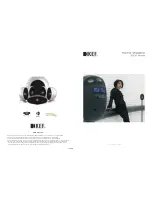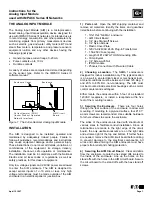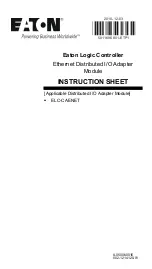
7
3.1 ELECTRICAL SUPPLY
The Solar system requires a 230/240 V ~ 50 Hz mains supply, fused at 3 A -
The system must be earthed.
There must only be one common isolator, providing complete electrical isolation, for the Solar system.
This system has been fitted with a supply cable, however, if it is necessary to fit a cable use PVC insulated cable not
less than 0.75 mm² (24 x 0.2 mm) to BS 6500 Table 16. The system should be connected to a fused three pin plug and
unswitched shuttered socket outlet (both complying with BS 1363), or a fused double pole switch with a contact separation of
at least 3 mm in both poles.
Note:
There is no electrical connections between the boiler and the Solar system. Therefore, it is recommended that the
Solar system electrical isolation is completely separate to the boiler and any external controls isolation.
All wiring must be in accordance with the current IEE Wiring Regulations (BS 7671).
3.2 DOMESTIC HOT WATER SYSTEM
Ensure that the cold mains and hot water pipes do not have any dead legs of pipework.
The mains water supply must be first connected to cold fill isolation valve and pressure reducing valve supplied with the
system. The incoming mains water pressure to the cylinder is then regulated to 2.5 bar by the pressure reducing valve.
However, all taps and mixing valves used with the hot water system must be suitable for operating at a pressure of up to 8 bar,
any cold connections to mixing and thermostatic type taps and showers must be taken from the solar cold feed after the pressure
reducing valve to balance the pressure and prevent any back feeding into the solar system.
The boiler inlet sensor supplied with the solar system should be connected to the boiler control panel (low voltage terminals
8 and 9) and the sensor clipped to the boiler inlet pipe to measure the temperature of the incoming solar water and give
better control of the outlet temperature and boiler efficiency.
Note:
The hot water control thermostat on the combination boiler
must always
be turned to maximum.
To ensure economic use, the pipe runs to the combination boiler and taps should be in 15 mm copper pipe and be as short
as possible. Where possible the pipework should be insulated to reduce heat loss.
Thoroughly flush out the mains water supply pipe before connecting it to the boiler and solar cylinder to avoid the danger of
dirt or foreign matter entering the system. Ensure the filter in the cold fill valve assembly is clear.
The temperature of the water in the solar cylinder is restricted to a maximum of 70°C. At this temperature the DBU pump is
switched off until the cylinder temperature is reduced.
To prevent high temperatures at the hot water taps, it is recommended that a thermostatically controlled mixing valve is fitted
after the boiler. As shown in Fig. 1.
If required for electrical backup heating, an optional immersion heater kit is available, Part No. 3.023153.
3.3 UNVENTED HOT WATER STORAGE SYSTEM
The installation is subject to Building Regulations approval and the Local Authority must be notified of the intention to install.
Discharge pipe -
The discharge pipes from the temperature/pressure and expansion relief valves are pre-formed and
factory fitted to the cylinder.
Tundish -
The tundish supplied must be connected underneath the cylinder, as shown in Fig. 1, so that it is visible to the
User and away from electrical devices. The minimum size of the discharge pipe downstream of the tundish is given in the
following table.
3 GENERAL INFORMATION
Alpha SolarSmart 100 - General Information
The discharge pipework from the tundish:-
1. Shall fall continuously through its length.
2. Shall be of a heat resistant material, e.g. metal.
3. Shall not be fitted with any valves or taps.
4. Shall discharge to a safe visible position, e.g. into a gulley.
5. Shall have a minimum of 300 mm straight pipework directly from the tundish.
Note:
Where children may play or otherwise come into contact with discharges, a wire cage or similar guard must be
positioned to prevent contact whilst maintaining visibility.
Resistance created
by each elbow
or bend
0.8 m
1.0 m
1.4 m
Maximum resistance allowed,
expressed as a length of straight
pipe (i.e. no elbows or bends)
up to 9 m
up to 18 m
up to 27 m
Minimum size of discharge
pipe 'D2' from tundish
22 mm
28 mm
35 mm
Minimum size of discharge
pipe 'D1' to tundish
15 mm
Valve
outlet size
G½
Sizing of copper discharge pipe 'D2' - refer also to Fig. 2 and 3








































